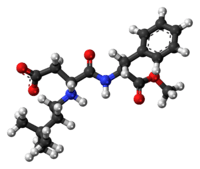Neotame
 | |
 | |
| Names | |
|---|---|
| IUPAC name
(3S)-3-(3,3-Dimethylbutylamino)-4-[[(2S)-1-methoxy-1-oxo-3-phenylpropan-2-yl]amino]-4-oxobutanoic acid | |
| Other names
E961; N-(N-(3,3-Dimethylbutyl)-L-α-aspartyl)-L-phenylalanine 1-methyl ester | |
| Identifiers | |
| 165450-17-9 | |
| 3D model (Jmol) | Interactive image |
| ChEBI | CHEBI:83503 |
| ChemSpider | 7986751 |
| ECHA InfoCard | 100.109.344 |
| E number | E961 (glazing agents, ...) |
| PubChem | 9810996 |
| UNII | VJ597D52EX |
| |
| |
| Properties | |
| C20H30N2O5 | |
| Molar mass | 378.47 g·mol−1 |
| Hazards | |
| NFPA 704 | |
| Except where otherwise noted, data are given for materials in their standard state (at 25 °C [77 °F], 100 kPa). | |
| | |
| Infobox references | |
Neotame is an artificial sweetener made by NutraSweet that is between 7,000 and 13,000 times sweeter than sucrose (table sugar).[1] In the European Union, it is known by the E number E961.[2] It is moderately heat-stable, extremely potent, rapidly metabolized, completely eliminated, and does not appear to accumulate in the body.[3]
The major metabolic pathway is hydrolysis of the methyl ester by esterases that are present throughout the body, which yields de-esterified neotame and methanol. Because only trace amounts of neotame are needed to sweeten foods, the amount of methanol derived from neotame is much lower than that found in common foods.[3]
The product is attractive to food manufacturers, as its use greatly lowers the cost of production compared to using sugar or high fructose corn syrup (due to the lower quantities needed to achieve the same sweetening),[4] while also benefitting the consumer by providing fewer "empty" sugar calories and a lower impact on blood sugar.
Chemistry
It is chemically similar to the artificial sweetener aspartame, but is used at vastly lower levels and is more stable.[5] Chemically, it has a 3,3-dimethylbutyl group attached to the amino group of the aspartic acid portion of the molecule. Peptidases, which would typically break the peptide bond between the aspartic acid and phenylalanine moieties, are effectively blocked by the presence of the 3,3-dimethylbutyl moiety, thus reducing the production of phenylalanine during metabolism of the chemical. As a result, it is safe for consumption by those who suffer from phenylketonuria.[6]
Approval
Neotame was approved by the Food and Drug Administration (FDA) for general use in July 2002, and in November 2011[7] by the EU to become a classified E number (E961), but it is not yet widely used in food products. Neotame also is approved for use in Australia and New Zealand. It is assigned the International Numbering System (INS) food additive code 961.[8]
Although over 100 corporate-sponsored studies were conducted on neotame to prove its safety prior to FDA approval,[9] the controversy relating to a related sweetener, aspartame, has caused a stir among opponents of that additive. However, neotame is the only artificial sweetener ranked as "safe" by the consumer advocacy group Center for Science in the Public Interest.[10]
Patent
The patent covering the neotame molecule in the US, 5,480,668,[11] was originally set to expire 7 November 2012, but was extended 973 days by the U.S. Patent and Trademark Office. The patent expired on 8 July 2015.[12]
References
- ↑ Mayhew, DA; Meyers BI; Stargel WW; Comers CP; Andress SE; Butchko HH (2012). "9. Neotame". In Lyn O'Brien Nabors. Alternative Sweeteners. CRC Press. pp. 133–. ISBN 978-1-4398-4614-8. Retrieved 29 January 2013.
- ↑ "New additives approved for use". Food Standards Agency UK. 2010-11-26.
- 1 2 Abbott, P. J. (2004). "Neotame". JECFA. International Programme on Chemical Safety. Retrieved 2007-08-31.
- ↑ "Cost is the key to neotame's success". Food Navigator USA. 2005-03-04. Retrieved 2007-08-31.
- ↑ Nofre, C.; Tinti, J.-M. (2000). "Neotame: Discovery, properties, utility". Food Chemistry. 69 (3): 245–257. doi:10.1016/S0308-8146(99)00254-X.
- ↑ "Neotame". Ingredient Listings. Science Toys. Retrieved 2007-08-31.
- ↑ "New additives approved for use".
- ↑ "JECFA Evaluations - Neotame". Summary of evaluations performed by JECFA. International Life Sciences Institute. Retrieved 2008-04-16.
- ↑ "Neotame Science Brochure" (PDF). Neotame.com.
- ↑ "Comparison and Safety Ratings of Food Additives". Center for Science in the Public Interest.
- ↑ "USPTO 5,480,668". Retrieved 2012-09-21.
- ↑ "USPTO extension of 5,480,668". Retrieved 2012-09-21.
External links
- Official Neotame Website, Sweeteners Holdings, Inc.
- Neotame Artificial Sweetener Approved by FDA
- food.gov.uk
